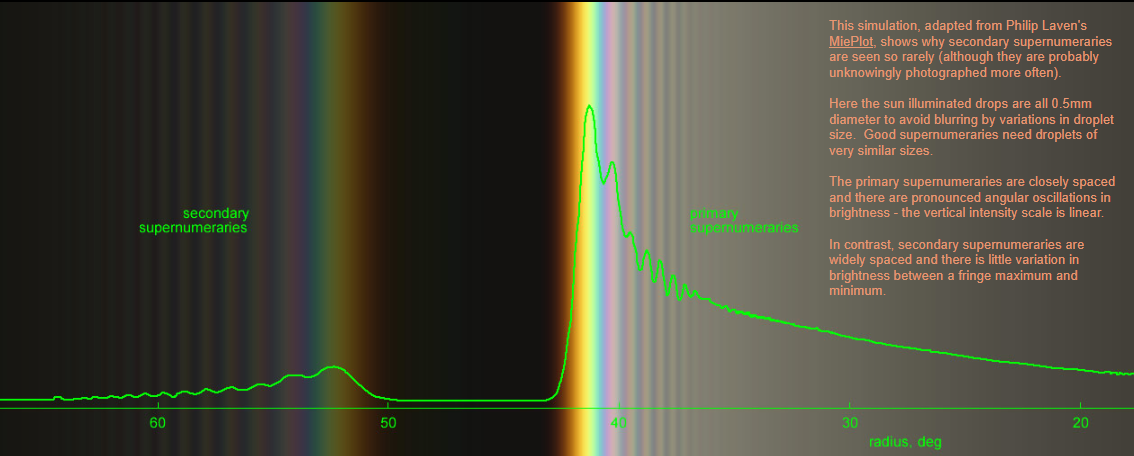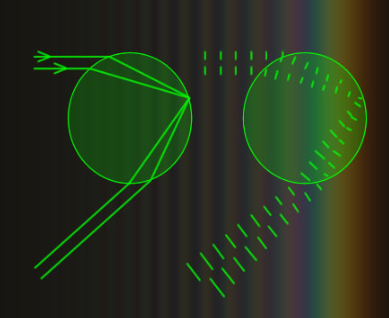OPOD - Secondary Rainbow Supernumeraries
OPOD - Secondary Rainbow Supernumeraries: A Rare and Fascinating Atmospheric Phenomenon
Rainbows have long captivated the human imagination with their vibrant colors and ethereal beauty. But there is more to these natural wonders than meets the eye. Among the various types of rainbows, secondary rainbow supernumeraries stand out as a particularly rare and captivating phenomenon. In this article, we will delve into the intricacies of secondary rainbow supernumeraries and explore why they are so rarely observed.
Unveiling the Mystery of Secondary Supernumeraries
Secondary rainbow supernumeraries are characterized by the presence of additional fringes of light above the outer secondary bow. While supernumeraries inside a primary bow are relatively common, observing them in a secondary bow is a rarity in itself. What makes this phenomenon even more remarkable is the occurrence of multiple secondary supernumeraries, as captured in a stunning image by Rob Noble from South Cambridgeshire, England.
The Elusive Nature of Secondary Supernumeraries
To understand why secondary supernumeraries are seldom seen, we turn to a simulation adapted from Philip Laven's MiePlot. The simulation reveals that good supernumeraries require droplets of very similar sizes, which is a challenging condition to meet. In contrast to primary supernumeraries, which are closely spaced and exhibit pronounced angular oscillations in brightness, secondary supernumeraries are widely spaced and show little variation in brightness between fringe maxima and minima.
The Intricate Formation of Supernumeraries
The formation of primary supernumeraries provides valuable insight into the creation of secondary supernumeraries. At any point on a rainbow, two classical ray paths contribute to the light observed. However, light is not only a particle but also a wave phenomenon. Depending on the viewing angle and wavelength, the wave crests of the emerging waves can coincide or be out of phase. When the crests coincide, a bright arc known as a supernumerary bow is formed. This mechanism applies to both primary and secondary rainbows.
Unveiling the Rare Beauty of Secondary Supernumeraries
The rarity of secondary supernumeraries adds to their allure. While primary supernumeraries are relatively common, the occurrence of supernumeraries in a secondary rainbow is a sight that few have witnessed. The image captured by Rob Noble serves as a testament to the extraordinary nature of this atmospheric spectacle. The presence of multiple secondary supernumeraries makes this image all the more exceptional.
A Testimony to Mie Scattering
The simulation mentioned earlier not only sheds light on the rarity of secondary supernumeraries but also demonstrates the accuracy of Mie scattering predictions. The brightness inside the primary bow and the darkness of Alexander's dark band between the primary and secondary rainbows are faithfully reproduced in the simulation. This confirms the validity of Mie scattering theory in explaining the intricate optics behind these mesmerizing atmospheric phenomena.
Exploring the Unseen: The Original Article
For those eager to explore further, it is worth noting that this article has been automatically converted from the old site and may not appear as intended. However, the original article can be found on the Atmospheric Optics website, allowing enthusiasts to dive deeper into the captivating world of secondary rainbow supernumeraries.
In conclusion, secondary rainbow supernumeraries represent a rare and fascinating phenomenon within the realm of atmospheric optics. With their widely spaced fringes and minimal variation in brightness, these elusive spectacles have captivated the imaginations of observers worldwide. The image captured by Rob Noble serves as a testament to the exceptional nature of multiple secondary supernumeraries. As we continue to unravel the mysteries of our natural world, secondary rainbow supernumeraries stand as a testament to the breathtaking beauty and complexity of the atmospheric realm.

Secondary Rainbow Multiple Supernumeraries
Rob Noble imaged this very unusual rainbow from South Cambridgeshire, England. "It was late afternoon, a shower was clearing in the east and the sun was low on the western horizon." Above the outer secondary bow there are at least four supernumerary fringes. Mouse over the image to see them marked by green dots. Supernumeraries inside a primary bow are quite commonplace. A secondary bow supernumerary is rarely observed. Multiple secondary supernumeraries are rare indeed. ©Rob Noble, shown with permission.

This simulation, adapted from Philip Laven's MiePlot, shows why secondary supernumeraries are seen so rarely (although they are probably unknowingly photographed more often).
Here the sun illuminated drops are all 0.5mm diameter to avoid blurring by variations in droplet size. Good supernumeraries need droplets of very similar sizes.
The primary supernumeraries are closely spaced and there are pronounced angular oscillations in brightness - the vertical intensity scale is linear.
In contrast, secondary supernumeraries are widely spaced and there is little variation in brightness between a fringe maximum and minimum.
Note how well the Mie scattering prediction reproduces the brightness inside the primary bow and the darkness of Alexanders dark band between the primary and secondary rainbows.

At left the formation of primary supernumeraries is shown. Secondary ones form in the same way.
Two classical ray paths contribute to the light at any point on a rainbow.
But light is a wave phenomenon and the wave crests of the two emerging waves can coincide or be out of phase, depending on the viewing angle and wavelength. When the crests coincide there is a bright arc, a supernumerary bow.
Note: this article has been automatically converted from the old site and may not appear as intended. You can find the original article here.
Reference Atmospheric Optics
If you use any of the definitions, information, or data presented on Atmospheric Optics, please copy the link or reference below to properly credit us as the reference source. Thank you!
-
<a href="https://atoptics.co.uk/blog/opod-secondary-rainbow-supernumeraries/">OPOD - Secondary Rainbow Supernumeraries</a>
-
"OPOD - Secondary Rainbow Supernumeraries". Atmospheric Optics. Accessed on November 24, 2024. https://atoptics.co.uk/blog/opod-secondary-rainbow-supernumeraries/.
-
"OPOD - Secondary Rainbow Supernumeraries". Atmospheric Optics, https://atoptics.co.uk/blog/opod-secondary-rainbow-supernumeraries/. Accessed 24 November, 2024
-
OPOD - Secondary Rainbow Supernumeraries. Atmospheric Optics. Retrieved from https://atoptics.co.uk/blog/opod-secondary-rainbow-supernumeraries/.